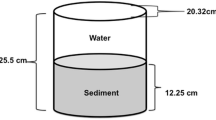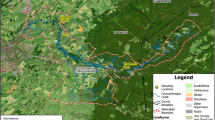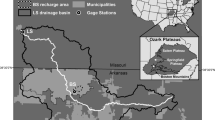Abstract
While the presence of fecal indicator bacteria such as Escherichia coli in urban stormwater has been widely documented, their occurrence and persistence in sediments are not as well understood. Recent investigations suggest that E. coli can accumulate in drainage basin sediments and act as a fecal bacterial reservoir within a watershed. We investigate the prevalence of E. coli populations in a tidal creek stormwater catchment and examine their interaction with overlying stormwater under wet and dry weather conditions. Two rain events are sampled more intensively with samples collected prior to, during, and after rainfall to profile bacteria in each matrix throughout a storm. Results of profile sampling and estimates of sediment resuspension provide evidence for E. coli accumulation during dry conditions and entrainment in overlying waters during storm conditions. Profile results suggest the occurrence of steady-state E. coli populations in drainage basin sediments.






Similar content being viewed by others
References
Ackerman, D., & Weisberg, S. B. (2003). Relationship between rainfall and beach bacterial concentrations on Santa Monica Bay beaches. Journal of Water and Health, 01, 85–89.
Ahn, J. H., Grant, S. B., Surbeck, C. Q., DiGiacomo, P. M., Nezlin, N. P., & Jiang, S. (2005). Coastal water quality impacts of stormwater runoff from an urban watershed in Southern California. Environmental Science and Technology, 39(16), 5940–5953.
ASTM D2974-07a. Standard test methods for moisture, ash, and organic matter of peat and other organic soils. Method D 2974–00. West Conshohocken: American Society for Testing and Materials.
Athayde, D.N., Shelley, P.E., Driscoll, E.D., Gaboury, D., Boyd, G. (1983). Results of the Nationwide Urban Runoff Program, NTIS PB84-185545, US Environmental Protection Agency.
Badgley, B. D., Thomas, F. I. M., & Harwood, V. J. (2011). Quantifying environmental reservoirs of fecal indicator bacteria associated with sediment and submerged aquatic vegetation. Environmental Microbiology, 13(4), 932–942.
Badin, A., Faure, P., Bedell, J., & Delolme, C. (2008). Distribution of organic pollutants and natural organic matter in urban storm water sediments as a function of grain size. Science of the Total Environment, 403(1–3), 178–187.
Barbier, E. B., Hackler, S. D., Kennedy, C., Koch, W. E., Stier, A. C., & Silliman, B. R. (2011). The value of estuarine and coastal ecosystem services. Ecological Monographs, 81(2), 169–193.
Boehm, A. B., Griffith, J., McGee, C., Edge, T. A., Solo-Gabriele, H. M., Whitman, R., Cao, Y., Getrich, M., Jay, J. A., Ferguson, D., Goodwin, K. D., Lee, C. M., Madison, M., & Weisberg, S. B. (2009). Faecal indicator bacteria enumeration in beach sand: a comparison study of extraction methods in medium to coarse sands. Journal of Applied Microbiology, 107(5), 1740–1750.
Byappanahalli, M., & Fujioka, R. (2004). Indigenous soil bacteria and low moisture may limit but allow faecal bacteria to multiply and become a minor population in tropical soils. Water Science and Technology, 50(1), 27–32.
Byappanahalli, M.N., Whitman, R.L., Shively, D.A., Sadowsky, M.J., & Ishii, S. (2006). Population structure, persistencem and seasonality of autochthonous of Escherichia coli in temperate, coastal forest soils from a Great Lakes watershed. Environmental Microbiology, 8(3), 504–513.
Chandran, A., Varghese, S., Kandeler, E., Thomas, A., Hatha, M., & Mazumder, A. (2011). An assessment of potential public health risk associated with the extended survival of indicator and pathogenic bacteria in freshwater lake sediments. International Journal of Hygiene and Environmental Health, 214(3), 258–264.
Craig, D. L., Fallowfield, H. J., & Cromar, N. J. (2004). Use of microcosms to determine persistence of Escherichia coli in recreational coastal water and sediment and validation with in situ measurements. Journal of Applied Microbiology, 96(5), 922–930.
Davies, C. M., & Bavor, H. J. (2000). The fate of stormwater associated bacteria in constructed wetland and water pollution control pond systems. Journal of Applied Microbiology, 89(2), 349–360.
Davies, C. M., Long, J. A. H., Donald, M., & Ashbolt, N. J. (1995). Survival of fecal microorganisms in marine and freshwater sediments. Applied Environmental Microbiology, 61(5), 1888–1896.
DiDonato, G. T., Stewart, J. R., Sanger, D. M., Robinson, B. J., Thompson, B. C., Holland, A. F., & Van Dolah, R. F. (2009). Effects of changing land use on the microbial water quality of tidal creeks. Marine Pollution Bulletin, 58(1), 97–106.
Evison, L. M. (1988). Comparative studies on the survival of indicator organisms and pathogens in fresh and seawater. Water Science and Technology, 20(11–12), 309–315.
Friedlander, R. S., Vlamakis, H., Kim, P., Khan, M., Kolter, R., & Aizeberg, J. (2013). Bacterial flagella explore microscale hummocks and hollows to increase adhesion. Proceedings of the National Academy of Sciences, 110(14), 5624–5629.
Fries, J., Characklis, G., & Noble, R. (2006). Attachment of fecal indicator bacteria to particles in the Neuse River Estuary, N.C. Journal of Environmental Engineering, 134(10), 1338–1345.
Fujioka, R. S., Hashimoto, H. H., Siwak, E. B., & Young, R. (1981). Effect of sunlight on survival of indicator bacteria in seawater. Applied Environmental Microbiology, 41(3), 690–696.
Geldreich, E. E., Best, L. C., Kenner, B. A., & Van Donsel, D. J. (1968). The bacteriological aspects of stormwater pollution. Journal of the Water Pollution Control Federation, 40(11), 1861–1968.
Guimaraes, W.B. (1995). Water quality in the Withers Swash Basin, with emphasis on enteric bacteria, Myrtle Beach, South Carolina, 1991–1993. US Geological Survey Water Resources Investigations Report 95–4120.
Harwood, V. J., Levine, A. D., Scott, T. M., Chivukula, V., Lukasik, J., Farrah, S. R., & Rose, J. B. (2005). Validity of the indicator organism paradigm for pathogen reduction in reclaimed water and public health protection. Applied Environmental Microbiology, 71(6), 3163–3170.
Jamieson, R. C., Joy, D. M., Lee, H., Kostaschuck, R., & Gordon, R. J. (2003). Persistence of enteric bacteria in alluvial streams. Journal of Environmental Engineering and Science, 3(3), 203–212.
Jamieson, R. C., Joy, D. M., Lee, H., Kostaschuck, R., & Gorrdon, R. J. (2005). Transport and deposition of sediment-associated Escherichia coli in natural streams. Water Research, 39(12), 2665–2675.
Jeng, H., England, A. J., & Bradford, H. B. (2005). Indicator organisms associated with stormwater suspended particles and estuarine sediment. Journal of Environmental Science and Health Part A Toxic/Hazard Substances and Environmental Engineering, 40(40), 779–791.
Jones, C. G., Lawton, J. H., & Schachak, M. (1994). Organisms as ecosystem engineers. Oikos, 69(3), 373–386.
Korajkic, A., Wanjugi, P., & Harwood, V. J. (2013). Indigenous microbiota and habitat influence Escherichia coli survival more than sunlight in simulated aquatic environments. Applied and Environmental Microbiology, 79(17), 5329–5337.
Lemarchand, K., & Lebaron, P. (2003). Occurrence of Salmonella spp. and Cryptosporidium spp. in a French coastal watershed: relationship with fecal indicators. FEMS Microbiology Letters, 218(1), 203–209.
Lord, B. N. (1987). Nonpoint source pollution from highway stormwater runoff. Science of the Total Environment, 59, 437–446.
Lu, J., Domingo, J. W. S., Lamendella, R., Edge, T., & Hill, S. (2008). Phylogenetic diversity and molecular detection of bacteria in gull feces. Applied and Environmental Microbiology, 75(13), 3969–3976.
Makepeace, D. K., Smith, D. W., & Stanley, S. J. (1995). Urban stormwater quality: summary of contaminant data. Critical Reviews in Environmental Science and Technology, 25(2), 93–139.
Mallin, M. A., Williams, K. E., Esham, E. C., & Lowe, R. P. (2000). Effect of human development on bacteriological water quality in coastal watersheds. Ecological Applications, 10(4), 1047–1056.
McClaine, J.W., & Ford, R.M. (2002). Characterizating the adhesion of motile and nonmontile Escherichia coli to a glass surface using a parallel-plate flow chamber. Biotechnology and Bioengineering, 78(2), 179–189.
Mehta, A., Hayter, E., Parker, W., Krone, R., & Teeter, A. (1989). Cohesive sediment transport. I: Process description. Journal of Hydraulic Engineering, 115, 1076–1093.
Noble, R. T., & Fuhrman, J. A. (2001). Enteroviruses detected by reverse transcriptase polymerase chain reaction from the coastal waters of Santa Monica Bay, California: low correlation to bacterial indicator levels. Hydrobiologia, 460(1–3), 175–184.
Partheniades, E. (1965). Erosion and deposition of cohesive soils. J Hydraul Eng-ASCE, 91, 105–139.
Paul, M. J., & Meyer, J. L. (2001). Streams in the urban landscape. Annual Review of Ecology and Systematics, 32, 333–65.
Radke D.B. (2005). Bottom-material samples. In: US Geological Survey TWRI book 9 (version 1.1), Handbooks for water-resource investigations (pp. 13–15).
Ram, J. L., Thompson, B., Turner, C., Nechvatal, J. M., Sheehan, H., & Bobrin, J. (2007). Identification of pets and raccoons as sources of bacterial contamination of urban storm sewers using a sequence-based bacterial source tracking method. Water Research, 41(16), 3605–3614.
Schillinger, J. E., & Gannon, J. J. (1985). Bacterial adsorption and suspended particles in urban stormwater. Journal Water Pollution Control Federation, 57(5), 384–389.
Shields, A. (1936). Application of similarity principles and turbulence research to bed-load movement. Hydrodynamics Laboratory Publ. No. 167, W. P. Ott, and J. C. van Uchelen, trans., US Dept. of Agr., Soil Conservation Service Cooperative Laboratory, California Institute of Technology, Pasadena, California
Solo-Gabriele, H. M., Wolfert, M. A., Desmarais, T. R., & Palmer, C. J. (2000). Sources of Escherichia coli in coastal subtropical environments. Applied Environmental Microbiology, 66(1), 230–237.
Tolleson, A. R., Wooten, J. M., Jenson, J. R., & Schill, S. (1998). Urban runoff analysis and evaluation in the coastal zone of Myrtle Beach. SC: Geometrics Inc.
US Environmental Protection Agency (1992). NPDES Stormwater Guidance Document. EPA 833-B-92-001.
US Environmental Protection Agency (1998). Water quality conditions in the United States: a profile from the 1998 National Water Quality Inventory Report to Congress, Office of Water, Washington, DC.
Wade, T. J., Pai, N., Eisenberg, J. N. S., & Colford, J. M. (2003). Do U.S. Environmental Protection Agency water quality guidelines for recreational waters prevent gastrointestinal illness? A systematic review and meta-analysis. Environmental Health Perspectives, 111(8), 1102–1109.
Wahl, M. H., McKellar, H. N., & Williams, T. M. (1997). Patterns of nutrient loading in forested and urbanized coastal streams. Journal of Experimental Marine Biology and Ecology, 213(1), 111–131.
Weiskel, P. K., Howes, B. L., & Heufelder, G. R. (1996). Coliform contamination of a coastal embayment: sources and transport pathways. Environmental Science and Technology, 30(6), 1872–1881.
Winfield, D. M., & Groisman, E. A. (2003). Role of nonhost environments in the lifestyles of Salmonella and Escherichia coli. Applied Environmental Microbiology, 69(7), 3687–3694.
Winter, T.C., Harvey, J.W., Franke, O.L., Alley, W.M. (1998) Ground water and surface water; a single resource. US Geologic Survey Circular 1139.
Zmirou, D., Pena, L., Ledrans, M., & Letertre, A. (2003). Risks associated with the microbiological quality of bodies of fresh and marine water used for recreational purposes: summary estimates based on published epidemiological studies. Archives of Environmental Health, 58(11), 703–711.
Acknowledgments
This research was funded by a US Army Corp of Engineers, Planning Assistance to the States grant (W912HN-10-2-0001), the M.K. Pentecost Ecology Fund, and the Coastal Carolina University Research Council. We would like to thank the City of Myrtle Beach Engineering and Stormwater departments for valuable information and maps regarding stormwater drainage, as well as providing access to weather station data. For guidance and assistance in sample collection and analysis, we thank the staff of the Coastal Carolina University Environmental Quality Lab.
Author information
Authors and Affiliations
Corresponding author
Electronic supplementary material
Below is the link to the electronic supplementary material.
ESM 1
(PDF 49 kb)
Rights and permissions
About this article
Cite this article
Curtis, K., Trapp, J.M. Evidence for the Accumulation and Steady-State Persistence of E. coli in Subtropical Drainage Basin Sediments. Water Air Soil Pollut 225, 2179 (2014). https://doi.org/10.1007/s11270-014-2179-3
Received:
Accepted:
Published:
DOI: https://doi.org/10.1007/s11270-014-2179-3




